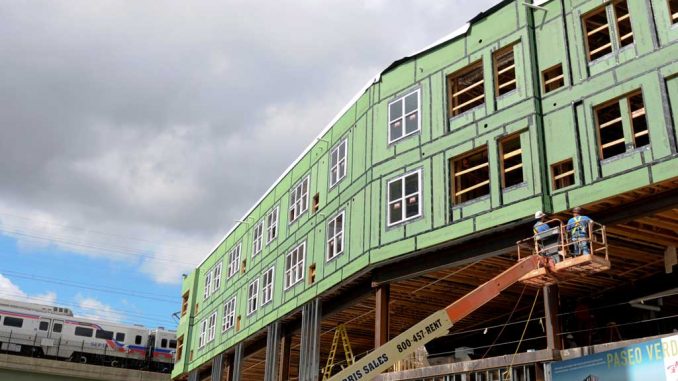
Fenced-off construction areas, the humming and beeping excavators and men in hardhats have become a fixture in the landscape near Temple, while development surges in the surrounding area.
However, the construction that commuter students may watch develop while waiting for an outbound SEPTA Regional Rail train is not related to the university or its students, but is part of an effort to revitalize the neighborhood that Temple shares with low-income Philadelphians.
Paseo Verde, a commuter-oriented residential complex being constructed at Ninth and Berks streets, is sponsored by Asociación Puertorriqueños en Marcha, or Association for Puerto Ricans on the March. Construction began in February.
Mayor Michael Nutter, City Council President Darrell Clarke and SEPTA General Manager Joe Casey joined the developers for a groundbreaking ceremony in April.
The building is set for completion in Spring 2013 and residents of Paseo Verde will be linked to the SEPTA train stop. The “green” complex features both affordable and market-rate housing. APM plans on moving its headquarters to the building’s ground floor, which it will share with social services, a health center, pharmacy and a Latino restaurant. The complex is part of APM’s vision to revitalize the neighborhood.
“Paseo Verde translates to walking through the green fields,” APM President and CEO Nilda Ruiz said.
Developers received a grant from Bank of America and Platinum LEED certification for the building, the highest possible Leadership in Energy and Environmental Design rating. Solar panels will be used, as well as low-flow fixture faucets, ENERGY STAR lighting and Green Label carpets. The building includes four blue roofs and three green roofs to reduce storm water runoff, Joanna Cuevas, project manager at Jonathan Rose Companies, said.
Green roofs will be accessible to residents, and a community garden will be planted on the second floor. APM believes that promoting sustainability is beneficial to both the community and its residents’ wallets.
“We believe that people thrive when the have access to outdoor space rather than being cooped up in a house,” Ruiz said. “People feel better, and when they feel better, they do better.”
APM aims to improve the financial situation of the neighborhood.
“People can improve their economic situation two different ways: make more money, or reduce expenses,” Ruiz said. “[Our] effort is to lower utilities and teach recycling, so that [the residents] can do more with their money.”
A Financial Opportunity Center on the ground floor will help money go further. People can check their credit and see what benefits they qualify for. Employment coaches will help connect residents to employers.
The building is split into two different types of residencies: 120 affordable housing units and 40 market-rate housing units. Those vying for an affordable unit must fill out an application and have their income checked, Cuevas said.
While APM is a Latino-based organization, its service to Latinos is not exclusive.
“APM is for everyone,” Ruiz said.
All who qualify are accepted on a first-come basis. Paseo Verde is one project with two funding streams. The budget for affordable housing is approximately $16 million, the market-rate is $31 million and the total project costs $47 million. The project is financed on federal, state and city levels, and receives tax credits for providing low-income housing, Cuevas said.
While APM officials said they discussed the project with Temple administrators, students will not necessarily be sought out as residents.
“We are looking for a diverse population,” Cuevas said.
APM plans on targeting Philadelphia Gas Works employees and Temple employees as potential residents for the market-rate housing.
APM officials said they believe Paseo Verde will ease the tension between the university and the neighborhood.
“There’s an attitude that ‘we’re over here and you’re over there,’ and the tracks create a natural barrier between the two communities,” Ruiz said.
By developing in the neighborhood on the east of the railroad tracks, Ruiz said she believes that the stark contrast between Main Campus and the area directly east will be lowered, and students and residents will feel welcome on either side.
“[The development] is convenient for a variety of people, and is a perfect location to allow for communities to interact,” Cuevas said.
The Temple stop on the Regional Rail is the fourth busiest stop in the SEPTA system. Developers hope that this strategic location along with employment coaching will help residents obtain jobs.
APM has hope for the area, but knows that change won’t happen over night.
“We are continuing to build. I don’t see us doing any less in the next 20 years of developing the area. It takes time,” Ruiz said.
APM holds monthly and quarterly meetings to ensure the community is interested and engaged with the steps that it is taking, Ruiz said.
“We want to have a clean, safe, walkable community,” Ruiz said.
Abi Reimold can be reached at areimold@temple.edu.



Be the first to comment